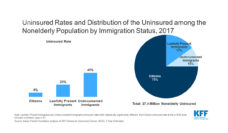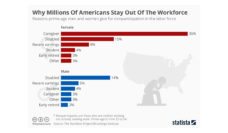Nearly 5 million disabled and older Americans rely on home health aides to address their basic needs. Home health aides help their clients with the tasks of daily living, like eating and showering, as well as clinical tasks, like taking blood pressure and leading physical therapy exercises. As the population gets a little older and a little sicker each year, disabled and older Americans rely more and more on home health aides. Up to 90% of older Americans want to age at home, and home health aides help them to do so. In the next 10 years, demand for direct care workers is anticipated to rise 34%, making it the third fastest-growing occupation in the country.
A recent study by Leah Zallman and colleagues examined the nativity status of direct care workers. In this study, direct care workers were people who worked in roles like nurses, nursing assistants, and home health aides. They found that immigrants made up a large share of the direct care workers, especially home health aides.
Nationally, 28% of the direct care workforce and 31% of home health aides are born outside the US. Legal non-citizen immigrants account for about 5% of the US population, but they make up 11% of the workforce in home health agencies and 26% of direct care workers in the informal sector. Unauthorized immigrants make up about 3% of the US population but over 4% of direct care workers.
The health care system in the US depends on over three million immigrants serving in health care roles.
Why do so many immigrants work in direct care roles? Since home health positions are in high demand, immigrants may see these roles as easily attainable employment. The majority of home health aides are uncertified. Home health aide certification requires only 75 hours of on-the-job training. Ease of employment translates to fast money to send home to family. Additionally, direct care workers may see their work as a pathway to higher prestige health occupations.
The health care system in the US depends on over three million immigrants serving in health care roles. Restrictive immigration policies threaten the substantial workforce of immigrants, both authorized and unauthorized, needed to care for elderly and disabled Americans. Almost 340,000 unauthorized immigrants were deported last year. Another 50,000 people were in ICE custody at the end of 2019. New immigrant arrivals have fallen under the Trump administration. Given the disproportionate number of immigrants in direct care roles, these policies affect the direct care workforce.
The US faces health care worker shortages that limit care. With the elderly population expected to double by 2050, direct care workers will be in short supply. As our population “grays,” we need substantial increases in the direct care workforce to meet demand. Without immigrants to fill a substantial portion of these roles, direct care shortages may be worse than previously estimated, leaving elderly and disabled Americans without the care they need.
Photo by Russell Tate on Unsplash














